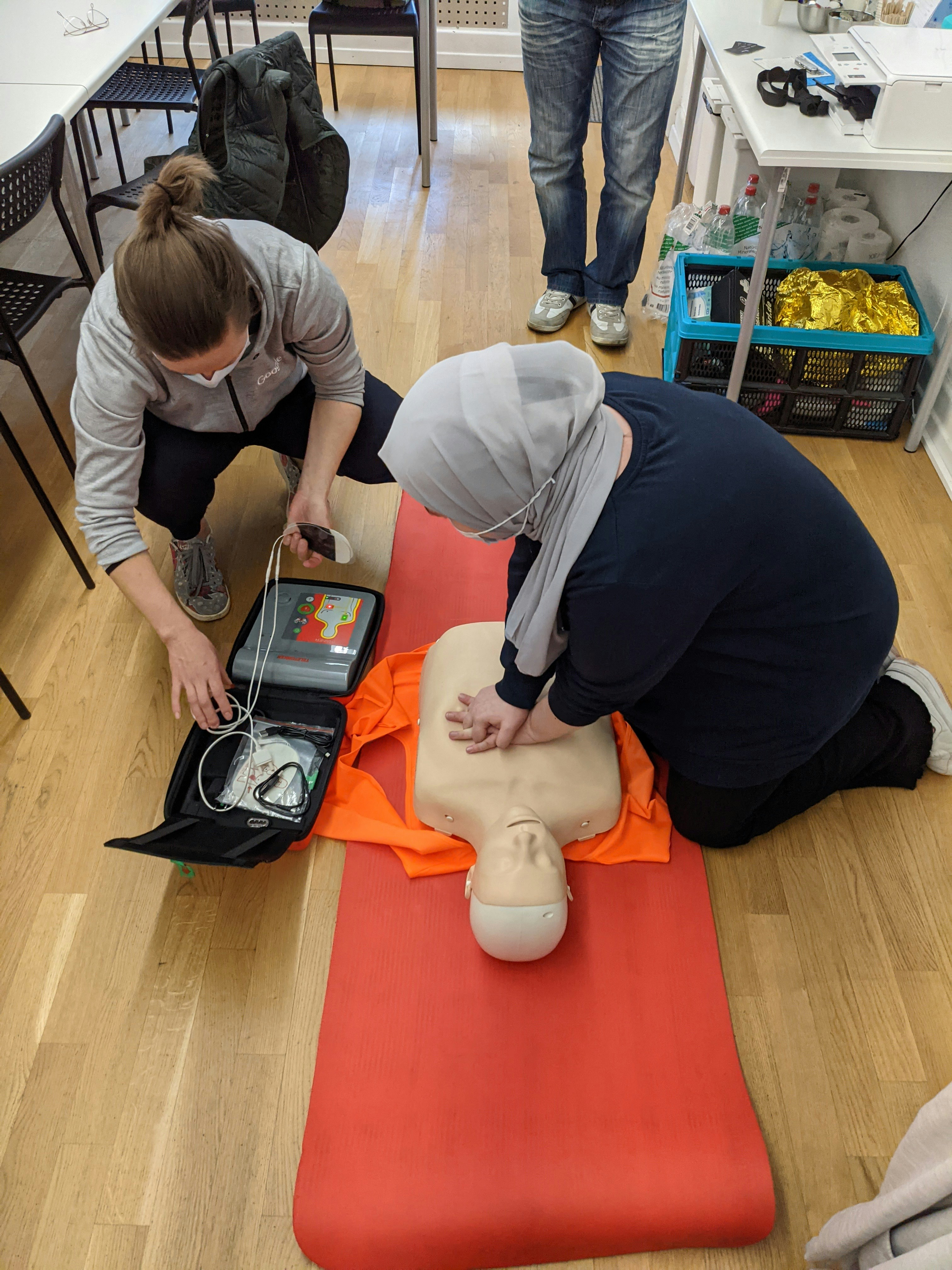Imagine you find yourself in a situation where someone suddenly collapses and their heart stops. Panic sets in, but don’t worry, you can make a difference! In this article, we will guide you through the essential steps of performing CPR in an emergency situation. From assessing the scene to providing chest compressions and rescue breaths, we will equip you with the knowledge and skills to potentially save a life. So, let’s get started and empower you with the confidence to take action in the face of a cardiac emergency.
Understanding the Importance of CPR
Cardiopulmonary Resuscitation (CPR) is a lifesaving technique that involves providing chest compressions and rescue breaths to a person in cardiac arrest. During a cardiac arrest, the heart suddenly stops beating, and blood flow to the vital organs, including the brain, is compromised. This is an emergency situation where every second counts, and knowing how to perform CPR can make a significant difference between life and death.
Definition of CPR
CPR, or cardiopulmonary resuscitation, is a technique that involves manually compressing the chest and providing rescue breaths to maintain blood flow and oxygenation to the body. It is a critical intervention in cases of cardiac arrest, where the heart stops pumping blood effectively.
The impact and value of CPR in emergencies
CPR plays a crucial role in emergencies as it helps to support blood circulation and oxygenation. By continuously performing chest compressions, you can maintain blood flow and keep vital organs supplied with oxygen until professional medical help arrives. Performing CPR immediately can double or even triple a person’s chances of survival.
Stats and data related to CPR effectiveness
Statistics and research studies have highlighted the significant impact of CPR in improving survival rates. According to the American Heart Association, only around 10% of people who experience a cardiac arrest outside of a hospital setting survive. However, bystander CPR can increase the chances of survival by two to three times. These numbers emphasize the importance of learning and being prepared to perform CPR in emergency situations.
Recognizing the Situations that Require CPR
Signs of cardiac arrest
Cardiac arrest can happen suddenly and without warning. It is essential to recognize the signs to determine if CPR is needed. Common signs of cardiac arrest include the person collapsing and becoming unresponsive, absent or abnormal breathing, and a lack of pulse.
Common circumstances that may require CPR
While cardiac arrest can occur in anyone, there are specific situations where the risk is higher. These situations include drowning incidents, drug overdoses, electrocution, heart attacks, and severe trauma. By being aware of these circumstances, you can be better prepared to recognize the need for CPR and take immediate action.
Differentiating between different types of emergencies
It is crucial to differentiate between various types of emergencies to determine the most appropriate interventions. For example, CPR is specifically indicated in cases of cardiac arrest, which is the cessation of the heart’s normal rhythm. However, situations such as choking, breathing difficulties, or allergic reactions may require different interventions. Being able to assess the emergency accurately allows you to respond in the most effective way possible.
Before Starting CPR: Key Precautions
Assessing the situation for safety
Before starting CPR, it is important to assess the situation and ensure your safety as well as the safety of the victim. Look out for any potential hazards, such as traffic, fire, or unstable structures, and remove yourself and the victim from harm’s way if possible.
Ensuring personal protection
CPR involves close contact with the victim and potential exposure to bodily fluids. It is crucial to protect yourself by wearing personal protective equipment (PPE) such as disposable gloves, a face mask, or a face shield. This helps reduce the risk of infection or transmission of diseases.
Confirming unresponsiveness of the victim
To determine if CPR is needed, you must first confirm that the victim is unresponsive. Tap the victim’s shoulder and ask loudly if they are okay. If there is no response, gently shake the victim and check for any signs of consciousness. If there is no response, it is time to initiate CPR immediately.
Calling Emergency Services
When to call 911
In most cases of cardiac arrest, it is crucial to call emergency services immediately. Call 911 as soon as you confirm that the victim is unresponsive and has no normal breathing or pulse. Early activation of emergency services ensures that professional help is on the way and can provide further guidance while you continue CPR.
Providing exact information to the operator
When calling emergency services, it is essential to provide accurate and specific information to the operator. Clearly state the location of the emergency, the nature of the situation (cardiac arrest), and any other relevant details. This helps the operator assess the severity of the situation and dispatch appropriate resources promptly.
Staying on the line and following the operator’s instructions
After providing the necessary information, it is crucial to stay on the line and listen carefully to the operator’s instructions. The operator may provide guidance on performing CPR or other steps to take while waiting for professional help. Following their instructions can improve the victim’s chances of survival and ensure a coordinated response to the emergency.
Chest Compressions: Step by Step Guide
Proper hand positioning for chest compressions
During CPR, correct hand positioning for chest compressions is essential to achieve adequate depth and effectiveness. Place the heel of one hand on the center of the victim’s chest, between the nipples. Place the other hand on top of the first hand, interlacing the fingers. Keep your elbows straight and your shoulders aligned directly above your hands.
The rhythm and depth of the compressions
To provide effective chest compressions, it is important to maintain the proper rhythm and depth. Push hard and fast, aiming for a compression depth of about two inches for adults and at least one-third of the chest depth for children and infants. The recommended compression rate is around 100-120 compressions per minute, ensuring the chest fully recoils between each compression.
Performing chest compressions on adults, children, and infants
While the technique for chest compressions is generally the same across all age groups, there are some key differences regarding hand placement and compression depth. For adults, chest compressions are performed with two hands, whereas for children and infants, compressions may be done with one hand or two fingers, respectively. Adapting the technique according to the victim’s age is crucial for effective CPR.
Conducting Rescue Breaths Properly
Tilting the head and lifting the chin
Before providing rescue breaths, it is important to open the airway by tilting the victim’s head back and lifting the chin. Use one hand to gently tilt the victim’s head backward while simultaneously lifting their chin with your other hand. This maneuver helps align the airway and facilitates effective ventilation.
Assessing for normal breathing
After positioning the airway, it is essential to assess if the victim is breathing normally or not. Look for chest rise and fall, listen for breath sounds, and feel for any airflow. If the victim is not breathing or only gasping, it is an indication to provide rescue breaths.
How to give rescue breaths to an adult, child, or infant
To give rescue breaths, provide a tight seal by placing your mouth over the victim’s mouth (adult and child) or nose and mouth (infant). Deliver a breath lasting about one second, ensuring that you see the chest rise. For adults and children, one rescue breath is given every 5-6 seconds, while infants require one breath every 3-5 seconds. Remember to allow the chest to fully deflate between each breath.
Continuing the CPR Process
The cycling of chest compressions and rescue breaths
CPR involves a cycle of chest compressions and rescue breaths. After providing the initial rescue breaths, immediately transition to chest compressions. Perform 30 chest compressions at the appropriate rate and depth, followed by two rescue breaths. Continue this cycle until trained medical personnel take over or until the victim shows signs of response.
Frequency and duration of CPR
CPR should be performed continuously until professional help arrives or until the victim shows signs of life. It is physically demanding, and fatigue may set in. However, it is crucial to maintain a consistent rhythm and depth of compressions throughout the process. If you are alone, prioritize calling emergency services and locating an automated external defibrillator (AED) if available.
When to stop performing CPR
The decision to stop performing CPR is typically made by trained medical personnel based on several factors, such as the victim’s overall condition, the duration of the cardiac arrest, and the presence of advanced life support measures. Until professional help arrives, it is essential to continue providing CPR without interruption, as every minute without oxygen further reduces the chances of survival.
Using an Automated External Defibrillator (AED)
What is an AED
An Automated External Defibrillator (AED) is a portable electronic device used to analyze the heart rhythm and deliver an electric shock if necessary. It is an essential tool that can significantly increase the chances of survival in cases of cardiac arrest.
When and how to use an AED
AEDs are designed to be user-friendly and can be used by individuals with minimal training. When an AED is available, it should be used as soon as possible, ideally within the first few minutes of cardiac arrest. Follow the instructions provided by the device, apply the electrode pads to the victim’s bare chest, and allow the AED to analyze the rhythm. If a shock is advised, ensure that no one is touching the victim and press the shock button as instructed.
The role of AED in the CPR process
The AED is a crucial component of the CPR process as it can restore the heart’s normal rhythm by delivering an electric shock. CPR maintains blood flow to vital organs, while the AED can potentially reset the heart’s electrical activity. When used in combination, CPR and AED significantly improve the chances of survival for individuals experiencing cardiac arrest.
Dealing With Potential Challenges or Complications
Handling CPR for drowning victims
CPR for drowning victims follows a similar approach as in other cases of cardiac arrest. However, it is essential to remove the victim from the water before starting CPR. The rescue breaths may be more critical initially, as the drowning victim may have depleted oxygen levels. Providing prompt and effective CPR can help improve outcomes for drowning victims.
CPR for victims with vomiting or regurgitation
While vomiting or regurgitation may pose challenges during CPR, it is crucial to continue the resuscitation efforts. To minimize the risk of complications, care should be taken to clear the airway as best as possible and maintain proper head tilt and chin lift. Professional medical help should be sought if there are concerns or difficulties related to the victim’s airway.
Dealing with a hiatus hernia or gastroparesis
In cases where the victim has a known medical condition such as hiatus hernia or gastroparesis, it is important to adapt the CPR technique accordingly. When delivering rescue breaths, ensure that the victim’s airway is clear and that any regurgitated material is promptly cleared from the mouth. Focus on providing effective chest compressions as the primary intervention to maintain circulation.
Post CPR Actions and Considerations
What to do after EMS arrives
Once professional emergency medical services (EMS) arrive on the scene, it is essential to provide them with any relevant information and step back to allow them to take over. Be prepared to answer questions and provide details regarding the events leading up to the cardiac arrest and the actions taken during CPR. EMS personnel will continue to provide advanced life support measures and transport the victim to the appropriate healthcare facility for further treatment.
Coping with the emotional aftermath of performing CPR
Performing CPR can be a physically and emotionally demanding experience. It is not uncommon to experience a range of emotions such as stress, fear, anxiety, and even guilt after performing CPR. It is important to seek emotional support and debriefing from friends, family, or healthcare professionals to process the experience and cope with any potential trauma.
Importance of learning and refreshing CPR skills regularly
CPR skills and knowledge can become rusty over time, and it is crucial to regularly refresh and update these skills. Attending CPR training courses or programs periodically helps ensure that you are equipped with the most up-to-date techniques and guidelines. By staying knowledgeable and competent in CPR, you can continue to make a positive impact and potentially save lives during emergency situations.



